(10352)
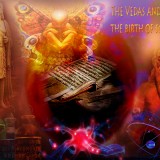
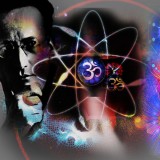
There is a legend about a magic tree, kalpataru, that fulfills all wishes. Indian civilization is this tree of riches and wisdom. Kings and emperors sought to conquer India for its material wealth; the campaign of Alexander, the unceasing attacks of the Turks, the voyage of Columbus, the British empire—these had India as the focus. Indian sages, philosophers and mystics have held out a shining vision that has appealed to the world. Even Alexander took Indian yogis back to Greece with him. Indian thought influenced not only China and Southeast Asia, it may also have provided key impulses to Western thought. We find the Indic people in West Asia in the second millennium BC in the Kassite kingdom of Babylon and the Mitannis of Syria. The father of the famous Queen Kiya of Egypt was the Mitanni king Tushratha (or Dasharatha). The Indic element has been seen in the beginnings of Greek art. It is quite conceivable that the religious traditions of West Asia preserve a remembrance of their Indic past.The modern mind was shaped after adoption by the West of the twin beliefs of living in harmony with nature and search for a scientific basis to reality. In the past 300 years, these ideas of universality and a quest for knowledge have transformed European and American society. Many of the greatest writers and scientists of the past 100 years have taken inspiration from these Indic ideas.
Erwin Schrödinger
Perhaps the most remarkable intellectual achievement of the twentieth century was quantum theory, which is at the basis of our understanding of chemistry, biology, and physics and, consequently, it is at the basis of the century’s astonishing technological advances. One of the two creators of this theory was Erwin Schrödinger (1887-1961). In an autobiographical essay, he explains that his discovery of quantum mechanics was an attempt to give form to central ideas of Vedanta which, in this indirect sense, has played a role in the birth of the subject. In 1925, before his revolutionary theory was complete,
Erwin Schrödinger wrote:
This life of yours which you are living is not merely a piece of this entire existence,but in a certain sense the whole; only this whole is not so constituted that it can be surveyed in one single glance. This, as we know, is what the Brahmins express in that sacred, mystic formula which is yet really so simple and so clear: tat tvam asi, this is you. Or, again, in such words as “I am in the east and the west, I am above and below, I am this entire world.”
Schrödinger’s influential What is Life? (1944) also used Vedic ideas. The book became instantly famous although it was criticized by some for its emphasis on Indian ideas. Francis Crick, the co-discoverer of the DNA code, credited this book for key insights that led him to his revolutionary discovery. According to his biographer Walter Moore, there is a clear continuity between Schrödinger’s understanding of Vedanta and his research: The unity and continuity of Vedanta are reflected in the unity and continuity of wave mechanics. In 1925, the world view of physics was a model of a great machine composed of separable interacting material particles.
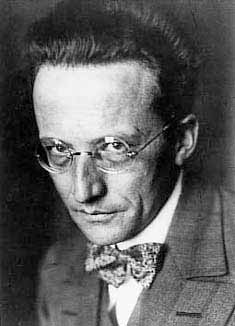 During the next few years, Schrödinger and Heisenberg and their followers created a universe based on superimposed inseparable waves of probability amplitudes. This new view would be entirely consistent with the Vedantic concept of All in One. He became a Vedantist, a Hindu, as a result of his studies in his search for truth. Schrödinger kept a copy of the Hindu scriptures at his bedside. He read books on Vedas, yoga, and Sankhya philosophy and he reworked them into his own words, and ultimately came to believe them. The Upanishads and the Bhagavadgita were his favourite scriptures.
During the next few years, Schrödinger and Heisenberg and their followers created a universe based on superimposed inseparable waves of probability amplitudes. This new view would be entirely consistent with the Vedantic concept of All in One. He became a Vedantist, a Hindu, as a result of his studies in his search for truth. Schrödinger kept a copy of the Hindu scriptures at his bedside. He read books on Vedas, yoga, and Sankhya philosophy and he reworked them into his own words, and ultimately came to believe them. The Upanishads and the Bhagavadgita were his favourite scriptures.
According to his biographer Moore, “His system—or that of the Upanishads— is delightful and consistent: the self and the world are one and they are all. He rejected traditional western religious beliefs (Jewish, Christian, and Islamic) not on the basis of any reasoned argument, nor even with an expression of emotional antipathy, for he loved to use religious expressions and metaphors, but simply by saying that they are naive.” Schrödinger was a professor at several universities in Europe. He was awarded the Nobel Prize in 1933. During the Hitler era he was dismissed from his position for his opposition to the Nazi ideas and he fled to England. For some years he was in Ireland, but after the conclusion of the World War II he returned to Vienna where he died in 1961.
Quantum mechanics goes beyond ordinary logic. According to it reality is a superposition of all possibilities which is very different from classical physics. It is quantum mechanics which explains the mysteries of chemical reactions and of
life. In recent years, it has been suggested that the secrets of consciousness have a quantum basis. In a famous essay on determinism and free will, Schrödinger expressed very clearly the sense that consciousness is a unity, arguing that this
 “insight is not new From the early great Upanishads the recognition Atman = Brahman (the personal self equals the omnipresent, all-comprehending eternal self) was in Indian thought considered, far from being blasphemous, to represent the quintessence of deepest insight into the happenings of the world. The striving of all the scholars of Vedanta was, after having learnt to pronounce with their lips, really to assimilate in their minds this grandest of all thoughts.”
“insight is not new From the early great Upanishads the recognition Atman = Brahman (the personal self equals the omnipresent, all-comprehending eternal self) was in Indian thought considered, far from being blasphemous, to represent the quintessence of deepest insight into the happenings of the world. The striving of all the scholars of Vedanta was, after having learnt to pronounce with their lips, really to assimilate in their minds this grandest of all thoughts.”
He thought the idea of pluralization of consciousness and the notion of many souls to be naive. He considered the notion of plurality to be a result of deception (maya): “the same illusion is produced by a gallery of mirrors, and in the same way Gaurisankar and Mt. Everest turned out to be the same peak seen from different valleys.”
Schrödinger was a very complex person. But he had a sense of humor and paradox. He called his dog Atman. Perhaps he did this to honour Yudhishthira whose own dog, an incarnation of cosmic justice (Dharma), accompanied him on his last march to the Himalayas. More likely, he was calling attention to the unity that pervades the web of life.
Erwin Schrödinger Quotes
‘The unity and continuity of Vedanta are reflected in the unity and continuity of wave mechanics. In 1925, the world view of physics was a model of a great machine composed of separable interacting material particles. During the next few years, Schrodinger and Heisenberg and their followers created a universe based on super imposed inseparable waves of probability amplitudes. This new view would be entirely consistent with the Vedantic concept of All in One’
‘Vedanta teaches that consciousness is singular, all happenings are played out in one universal consciousness and there is no multiplicity of selves.’
‘Nirvana is a state of pure blissful knowledge.. It has nothing to do with individual. The ego or its separation is an illusion. The goal of man is to preserve his Karma and to develop it further – when man dies his karma lives and creates for itself another carrier.’
‘There is no kind of framework within which we can find consciousness in the plural; this is simply something we construct because of the temporal plurality of individuals, but it is a false construction….The only solution to this conflict insofar as any is available to us at all lies in the ancient wisdom of the Upanishad.’
‘The multiplicity is only apparent. This is the doctrine of the Upanishads. And not of the Upanishads only. The mystical experience of the union with God regularly leads to this view, unless strong prejudices stand in the West.’
‘After the conversations about Indian philosophy, some of the ideas of Quantum Physics that had seemed so crazy suddenly made much more sense.’
“Some blood transfusion from the East to the West” to save Western science from spiritual anemia.”
(24282)
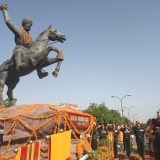
Atop the rooftop of the world – standing before serene waters of Lake Mansoravar on the Himalayan Plateau the crisp mountain air was broken with the cries of ‘Har Har Mahadev’. A band of Hindu warriors, bloodied and battered a thousand miles from their homes in the Jammu kingdom looked with grim satisfaction on the culmination of a successful campaign of war under the leadership of their inspirational leader General Zorawar Singh Kahluria.
The northern Indian kingdom of Jammu was ruled for my centuries by various Hindu clans and in themed 19th century was ruled by the Gulab Singh. For many centuries the Jammu kingdom had maintained a solid independence from the empires of northern India. Nominally allied to the Sikh kingdom of Lahore the warrior clans of the Dogras sought opportunities to the north of their kingdom.
Zorawar Singh initially conquered the hill region of Kishwar from its Nawab and the speed and ease of the conquest encourages further ambitions. The majority of Northern India was by this time under the heel of British Imperialism and the areas to the south and west were under the control of their allies the Sikhs. In 1834 he led his Dogra warriors into the remote and previously thought inaccessible regions of Ladakh which today forms part of the Jammu and Kashmir state of India. After defeating the Botis in a bitter engagement his added Kargil to his conquests. The Ladakhis gathered together a large force with assistance from the Chinese imperial army and despite being cut off from his base and with limited supplies Zorawar Singh managed to inflict a decisive defeat on his enemies under the leadership of the Gyalpo.
Although nominally allies the Sikh Kingdom was alarmed by the increasing power of the Dogras and under the instigation of Mehan Singh, the Sikh governor of Kashmir the Ladakhi again resumed the conflict with the Dogras the following year in 1836. However making a lightening march he managed to surprise and destroy the Ladakhi army and inflict a devastating defeat on them thus adding the vast Ladakhi regions to India.
To the north of Ladakh lies Baltistan (in modern Pakistan). General Zorawar Singh now turned his hardy mountain troops in this direction. The Nawab, Muhammad Shah had attempted to help the Ladakhis in the previous battles and in 1841 faced bitter retribution from Zorawar Singh and his Dogra warriors. Despite facing the bitter cold and extreme hardship the Dogras managed to invest and conquer the region in the same year. The fighting abilities of Zorawar Singh allowed the Dogras to proceed to even further ambitions towards Central Asia. Once again however the Sikhs complained to the Dogras that Zorawar Singh was pushing his conquests to areas which were their allies and thus Zorawar Singh turned his attention to the vast kingdom of Tibet to the north. Under the rule of Chinese Empire the plateau of Tibet was also home the sacred lake of Mansoravar and Mount Kailash the abode of Lord Shiva. In 1841 he divided his forces into three columns and headed into the vast unknown of the mighty Himalayas.
After a number of fierce engagements the Chinese troops fled before the ‘Shen Pa’ their name for the Hindu Dogra warriors and fighting both local resistance and the unsparing Himalayan weather Zorawar Singh and his soldiers reached their goal and to complete their pilgrimage. Author Dr Alex McKay further mentions in his book The History of Tibet,
‘The occupation Of Tibetan areas west of the Mayum pass was completed by the middle of September. General Zorawar Singh made proper arrangements for guarding advance posts towards the Mayum pass and other passes by posting his own contingents. He then returned to Tirathpuri where he intended to pass the winter.Thus the Dogra General conquered about 720 km. Of the Tibetan territory (linear distance) in about three and a half months .The first thing Zorawar Singh did after the conquest Of Misra was to take a holy bath in the lake Manasarovar and offer a golden idol at the Kailash temple On The mobilisation of his troops into Tibet he had already announced his intention to perform a pilgrimage of the Hindu holy places of the’ Kailash-kshetra. He now proudly fulfilled that resolve. Thus, by fighting out his way to these holy places and earning the merit of the pilgrimage of Kailash, to which the heroes of the Mahabharata had also retired after attaining the glory and fame in the battlefield of Kurukshetra, General Zorawar Singh had earned both sanctity and renown. He had achieved the height of fame.’
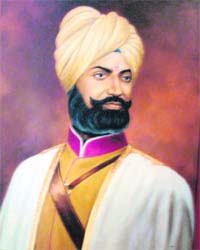 Now standing over 500 miles from his home base and rapidly facing mounting numbers of enemies he turned to return to his home. However by now the enemy had reinforced their strength in vast numbers and in the bitter winter of 1841-1842 suffering from a collapse of their supply lines, facing the relentless Himalayan winter and facing the Chinese/Tibetan forces on all sides the Dogras began to fight their way home.
Now standing over 500 miles from his home base and rapidly facing mounting numbers of enemies he turned to return to his home. However by now the enemy had reinforced their strength in vast numbers and in the bitter winter of 1841-1842 suffering from a collapse of their supply lines, facing the relentless Himalayan winter and facing the Chinese/Tibetan forces on all sides the Dogras began to fight their way home.
With each step being fiercely contested it was only the matchless general ship and valour of Zorawar Singh that maintained the discipline and strict order of his army. Inspired by the success of their holy pilgrimage to the sacred lake the Dogras kept at bay the forces of their enemies until brought to bay at the Battle of To-yo in December 1841.
Wounded by bullet in his right shoulder the general continued to rally his troops until in the thick of the fighting a spear was thrust into his shoulder – Wounded he was dragged out from the struggle by his soldiers and a shot while after died from his injuries.
The Chinese-Tibetan attack then moved forward but was resisted by the Dogra general Mehta Basti Ram – the Chinese then followed up their success by an attack on Ladakh but there faced a severe defeat at Dragntese when following the inspirational ideal of Zorawar Singh the Dogras managed to outflank their enemies and by damming the river managed to flood the enemy forces – At the Battle of Chushul the Dogras inflicting a decisive defeat on the Chinese and executed their general to avenge the death of Zorawar Singh
So ended the life and career of one of India greatest and yet least known warriors. His intrepid courage and general ship earned him the title of the ‘Napoleon of India’ from the Europeans His exertions far beyond the confines of modern India into the vast steppes and mountains of Central Asia were an example of the intrepid Hindu spirit and ethos which has allowed the Hindus to emerge from millennia of history.
Forgotten memorial to General Zorawar Singh where he died.
Toyo, Taklakot, Tibet – that is the hallowed place where stands a dilapidated Samadhi of a brave man called General Zorawar Singh, a Kahluria Rajput of the 19th century India. He was born in 1786 in the Kangra district but his bravery blossomed in the Dogra army of Raja Gulab Singh of Jammu.Brigadier Chitranjan Sawant
(23456)
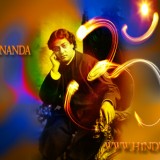
[box_light]Swami Vivekananda is one of the most famous Hindu saints of the modern age. He is considered by many as a heralder of a new era for Hinduism, being the first person in the modern age to travel to the West and give the message of Vedanta to an international audience. Yoga practitioners in the west recently celebrated the centenary of his first journey to the west as the birth of the international practice of yoga.[/box_light]
Early Life
Vivekananda was born in Calcutta, named Narendra. He was imbued with virtues at a young age, and was a melodious singer, alert student and powerful athlete. His spiritual longing led him to search far and wide for ideas about God, from all religions and teachers. But his scientific nature would not let him believe. Doubts flooded his mind. Yet these doubts far from being a bad thing, actually propelled him on his journey. On the advice of his schoolteacher, Narendra visited Ramakrishna Paramhansa. Narendra was taken aback by the reply he got to his questions about God: “not only have I seen God, but I can show you God if you like.” Narendra was uncertain, but Ramakrishna knew he would be back. “My son I’ve waited my whole life for you,” Ramakrishna cried with emotion. Narendra subsequently made Ramakrishna his Guru, and he both studied the masses of ancient Hindu knowledge both from a scholarly and experiential perspective. Later he attained the name of Swami Vivekananda.
Social Revolutionary
Swamiji traveled extensively around India and was shocked by what he saw. He saw the beauty of the ancient spirituality of the land still intact, but unimaginable poverty, poor health, social ills that rent his heart. He tried to mobilise the affluent classes to come to the aid of their fellow countrymen. He was shocked observing the massive and ruthless conversion campaigns of the Christian missionaries who were flooding India with government support. He warned that India may become a land with barely a memory of its past and true culture, much like Africa of today (which is today dominated by Christianity and Islam, and forgetful and ignorant about any insights and achievements of their ancestors). Many people were impressed with Swami Vivekananda and slowly his following grew. He also set up the Ramakrishna Vedantic Mission.
Travels to the West
Swami Vivekananda journeyed to the West, speaking at the Parliament of Religions at Chicago. He was allocated only 5 minutes, but held the audience in rapture for much longer, drawing large applause. He travelled to many places. For the first time, people realised that there is something unique and different about the culture and religion of the sub-continent of India, that provided a spirituality beyond the cold confines of organised and authoritarian creeds that they were accustomed to. He developed a following, some of whom would provide a mighty service to India’s upliftment, including Margaret Nobles, who later became Sister Nivedita. Swami Vivekananda was also met with bitter hostility and resistance at the hands of some. Stories of slander and scandals would appear in newspapers regularly, to try and stunt his influence. Swamiji later narrated that the more resistance he encountered, the more determined he became.
Restoring India’s Battered Confidence
Understandably, due to being in the midst of the second great colonialisation many thinkers and activists in India had lost faith in their heritage and were on the way to have their minds and hearts totally yearning after an imitation of England and Europe. Swamiji’s life had a deep impact on the Indian elite. A later Prime Minister of India later declared “We were at that time depressed at the state of our country, but Swami Vivekananda returned to us a lost dignity. We realised that while at present we do not have the wealth or power of Britain, we still had the real article, something that they did not have.”
His vision
It was Swamiji’s hope that India would create a new social order and a new civilisation by combining her best spiritual traditions with the latest advancements in science and technology. She would be rich both materially and spiritually. He knew affluence was not enough to make humanity satisfied, and that it was humanity’s place to manifest the will and light of the divine in the world. He wanted India to set an example in this, and be a harbinger in a new age, where the world would be both materially and technologically healthy, but spiritually and culturally advanced also.
(2769)

Amongst the sacred points of pilgrimages of Hinduism one of the most popular regions centre around the fabled birthplace and playground of Sri Krishna known as the Braj Matsya region. This area centred around the south of Delhi is annually visiting today as in the past by thousands of the faithful often humbly treading the paths between Mathura, Vrindavan and Gokul.
However in 1757 the sacred soil of Gokul was streaming with blood. The invasion of the Afghan invader Ahmed Shah Abdali sent hordes of his soldiers pouring into the holy places. After a desperate resistance by the Hindu Jats under their prince Jawahar Singh and the death of 10,000 of his solders the city of Mathura was sacked and brutalised.
Amidst the wholesale destruction of temples and holy places thousands of women flung themselves into the Yamuna River to escape rape and slavery. Vrindavan faced a similar horror. He had detached Jahan Khan and Najib with 20,000 men, telling them,
[box_light]“Move into the boundaries of the accursed Jat, and in every town and district held by him slay and plunder. The city of Mathura is a holy place of the Hindus ;… let it be put entirely to the edge of the sword. Up to Agra leave not a single place standing”[/box_light]
Vrindavan, seven miles north of Mathura, could not escape, as its wealth was indicated by its many temples. Here another general massacre was practiced upon the inoffensive monks of the most pacific order of Vishnu’s worshippers, (c. 6 March.) As the same Muhammadan diarist records after a visit to Vrindavan,
[box_light]“Wherever you gazed you beheld heaps of slain ; you could only pick your way with difficulty, owing to the quantity of bodies lying about and the amount of blood spilt. At one place that we reached we saw about 200 dead children lying in a heap. Not one of the dead bodies had a head . . . The stench and effluvium in the air were such that it was painful to open your mouth or even to draw breath.”[/box_light]
The prime general of the Afghans, Sardar Khan ; launched an attack on Gokul. Here however stirred by the atrocities of the Afghans thousands of ash smeared warrior monks barred the way. The grim Naga sadhus armed with swords, matchlocks and cannons had called together their wandering bands to rise in defence of dharma.
In the mid seventeenth century the bands of sadhus and assorted holy men coalesced into larger groups often numbering more than 10,000 strong – they provided protection to the temples, the travel routes and even towns and rival armies. For many centuries the monks and disciples began to take up arms amidst the upheavals of northern India and during the fall of the Mughal Empire they emerged as a serious force to reckon with.
One of their notable leaders Rajendra Giri Gosain held such a reputation of bravery that his band of Nagas would contend with over ten times their numbers of enemies with utter abandon and fury. Later times saw some of the larger bands under Himmat Bahadur and Anupgir Gosain lead vast armies across the northern Indian plains
The famed Afghan cavalry launched itself against the Nagas to be met with a wild and reckless counter charge by the Nagas. The utter disregard for their own lives displayed by the Hindu holy men sent the initial Afghan attackers retreating in confusion and defeat. Reinforced some time later the Afghans returned to the attack and a bitter struggle ensued.
Both parties believed they fought for a higher power but the similarities ended there. The Afghans fought for loot, plunder and rape whilst the Naga Sadhus had already given up their worldly and material attachments and in a long tradition of warfare fought solely for dharma and faith. The Afghans fought with the reckless valour for which they were much wonted and the Nagas fought with a determination that spoke of their contempt of death.
The battle cry of ‘Har Har Mahadev’ and ‘Ya Ali’ rose above the groans and shrieks of the wounded and dying. The battle raged as dusk fell and the protagonists continued their fight stepping on the bodies of the slain until the writer observes grappling in a deathly embrace whilst slipping on the mounds of gore and blood flowing on the hallowed grounds. Still the Nagas did not give ground.
Enraged the Abdali threw further troops into the battle. His as yet undefeated soldiers who had marched victoriously from the borders of India to Central Asia were met with renewed charges and attacks from the Naga Sanyasis. They fought so desperately that the Afghans began to lose hope of victory and as their losses rapidly mounted in the failing light their leader Sardar Jahan Khan called a retreat and the Afghans fell back in defeat and humiliation leaving many thousands of their brethren dead and wounded on the battlefield. The holy town of Gokul was saved but at an appalling cost in lives.
The Naga Sadhus saved the shrines of their faith and the thousands of refugees behind them. They exemplified the age old tradition of valour mixed with dharma – the concept of rising in arms each time they were required. They went on to fight bitter decade’s long struggles with the British expansion in India to be so famously celebrated in the late nineteenth century novel Ananda Math. Their exploits became the inspiration for the freedom fighters of the 20th Century and the living image of the warrior saints can be found in India today.
(35559)

Coming Soon
(2290)
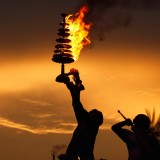
Coming Soon
(2088)
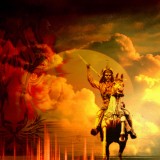
By the 1730s the Mughal Empire lay in ruins.The rulers of Delhi, the ‘Padshahs of the world’ had been humbled and the successors of Aurangzeb lived in terror of the revolutions convulsing the subcontinent of India. The spectre of religious fanaticism in the late 1600s had led to a revolt by the Hindu populace of India from the foothills of the Himalayas, the Rajputs of Rajasthan, The Jaats of Bharatpur, the Bundelas of Central India, the Satnamis of North India, The Kolis and Bhils of Gujarat, The Bedars of South India and the Ahoms of Eastern India.
None however provoked as much terror and fear in the hearts of their enemies as the slogan of the Hindu Padshahi coined by the first great leader Shivaji of the irresistible cavalry pouring from the arid hills of Western India. These were the Hindu Marathas. From the inspiration of Shivaji and Sant Ramdas they unleashed such energies into India that the Mughal Empire fell in ruin.
Following the death of Shivaji and the 27 year war of liberation the Marathas freed their homeland from Mughal tyranny when the son of the prime minister, a 19 year old named Baji Rao made an inspired speech in the court of the Maratha king.
[box_light]
‘Strike, strike at the heart of the rotting tree and the branches will fall of themselves. Then this land of the Hindus will be free’
[/box_light]
He then embarked on a ceaseless twenty year campaign in a strike northwards, every year inching nearer to Delhi and the extinction of the Mughal Empire. It is said that the Mughal emperor was in such terror that he refused a meeting with Baji Rao, fearing to sit in his presence. The holy pilgrimage routes of the Hindus from Mathura, to Benares to Somnath were made free of harassment.
The greatest of the warriors of the empire, Mughal, Pathan and Central Asian alike were defeated by Baji Rao: Nizam ul Mulk, Khan I Dauran, Muhammad Khan are but a few of the names of the warriors who failed before the Marathas. The Battles of Bhopal, Palkhed, the victories over the Portuguese invaders in Western India are amongst his great achievements.He died at the untimely age of 39 in 1739, in military camp surrounded by his army.He has been described as the incarnation of Hindu energy, ceaselessly striving for 20 years to establish the Hindu Padshahi.
His sons continued his mission of carrying the saffron flag to the gates of Afghanistan in 1758 to the fort of Attock in the North and simultaneously marching to the Southern shores of India. He represents the creative and destructive power of Dharma as he unleashed the urge of a people yearning to be free and remains as a symbol of victory to the modern day.
What others said :
J. Grant Duff says in “History of the Marathas”:
“Bred a soldier as well as a statesman, Baji rao united the enterprise, vogour, and hardihood of a Maratha chief with the polished manners, the sagacity, and address which frequently distinguish the Brahmins of the Concan. Fully acquainted with the financial schemes of his father, he selected that part of the plan calculated to direct the predatory hordes of Maharashtra in a common effort. In this respect, the genious of Baji rao enlarged the schemes which his father devised; and unlike most Brahmins of him, it may be truly said- he had both- the head to plan and the hand to execute.
“Sir R. Temple says in “Oriental Experiences”:
“Bajirao was hardly to be surpassed as a rider and was ever forward in action, eager to expose himself under fire if the affair was arduous. He was inured to fatigue and prided himself on enduring the same hardships as his soldiers and sharing their scanty fare. He was moved by an ardour for success in national undertakings by a patriotic confidence in the Hindu cause as against its old enemies, the Muhammadans and its new rivals, the Europeans then rising above the political horizon. He lived to seethe Maratha spread over the Indian continent from the Arabian sea to the Bay of Bengal. He died as he lived in camp under canvas among his men and he is remembered among the Marathas as the fighting Peshwa, as the incarnation of Hindu energy.
“Jadunath Sarkar says in his forward to “Peshwa Bajirao I and Maratha Expansion”
“Bajirao was a heaven born cavalry leader. In the long and distinguished galaxy of Peshwas, Bajirao Ballal was unequalled for the daring and originality of his genius and the volume and value of his achievements. He was truly a carlylean Hero as king- or rather as Man of action.’ If Sir Robert Walpole created the unchallengeable position of the Prime Minister in the unwritten constitution of England, Bajirao created the same institution in the Maratha Raj at exactly the same time.
“Surendra Nath Sen says in “The Military System of the Marathas”:
“The lover of Mastani knew well how to appeal to the religious sentiments of his co-religionists, although he could scarcely be considered an orthodox Brahman… Shivaji had given the Marathas a common cry, and none appreciated the potency of that cry clearly than Peshwa Bajirao. Shivaji’s military reforms he would not or could not revive, but he stood forth, as Shivaji had done, as champion of Hinduism. People of Central and Northern India saw in him a new deliverer.”
(11918)

The beginning of India’s history has been pushed back by more than 2,000 years, making it older than that of Egypt and Babylon. Latest research has put the date of the origin of the Indus Valley Civilisation at 6,000 years before Christ, which contests the current theory that the settlements around the Indus began around 3750 BC.Ever since the excavations at Harappa and Mohenjo-daro in the early 1920s, the civilisation was considered almost as old as those of Egypt and Mesopotamia.
The finding was announced at the “International Conference on Harappan Archaeology”, recently organised by the Archaeological Survey of India (ASI) in Chandigarh. Based on their research, BR Mani, ASI joint director general, and KN Dikshit, former ASI joint director general, said in a presentation: “The preliminary results of the data from early sites of the Indo-Pak subcontinent suggest that the Indian civilisation emerged in the 8th millennium BC in the Ghaggar-Hakra and Baluchistan area.”
“On the basis of radio-metric dates from Bhirrana (Haryana), the cultural remains of the pre-early Harappan horizon go back to 7380 BC to 6201 BC.” Excavations had been carried out at two sites in Pakistan and Bhirrana, Kunal, Rakhigarhi and Baror in India.
(2642)
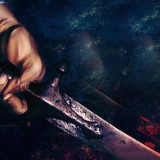
On the afternoon of January 14th over fifty thousand men lay dead on the ancient battlefield staining the holy ground with their blood. Afghan and Indian Muslim lay locked in a deadly embrace with their arch enemies, the Hindu Marathas of the Deccan.
After six hours of desperate combat the Marathas were overwhelmed by the tide of numbers of their enemies and their lines broke in despair. Their commander Sadashiv Bhau lay dead on the field surrounded by the bodies of twenty Afghans eventually giving his life in the hour of defeat .The Muslim coalition of Afghans, Pathans, Rohillas, Awadhis were victorious and marched to Delhi to celebrate their victory.
The Maratha Empire lay shattered with the death of Sadashiv Bhau and Vishwas Rao swiftly followed by the death of the Peshwa himself in grief, Balaji Baji Rao. Any yet in the defeat lay the seeds of recovery and their eventual victory over the Muslims.
The desperate struggle against the pan Islamic coalition unaided by any of the other Hindus in the regions such as the Rajputs, or Jats their campaigning in far flung regions such as Punjab and the borders of Afghanistan thousand of miles from their Deccan homeland gave them a sense of pride and achievement not seen for a thousand years amongst the Hindus of India. The hoisting of the saffron flag, Bhagwa jhanda, in the fort of Attock in modern Pakistan’s’ border with the Afghans fulfilled the prophecy of their first king Shivaji the Great.
By 1772 they were back in Delhi defeating the Pathans and in revenge pulled down their tombs and monuments of victory even consigning the remains of Najib Khan to the fire after pulling it from his grave.The courage of the army in 1761 became as a legend to the Maratha warriors who followed. The fight to the death of 60,000 famished soldiers on starving mounts against 120,000 Afghans led by one of the best generals of the day,Ahmed Shah Abdali.
On the morning of January 14th after being besieged for over two months and facing imminent starvation the Maratha soldiers clamoured around the tent of their commander Sadashiv Bhau asking to be led in a final struggle as it was better to die fighting than of starvation. Their commander dipped their hands in henna and impressed them upon some parchment as a signal of their determination. The Marathas then lined up to face their foes, twice their number. The rest is best described by an eyewitness in the Afghan army quoting from his memoirs and the letters of Ahmed Shah Abdali himself,
[box_light]
“Across the centre of the Maratha army a huge saffron banner hung, and after the marching ceased and some discharge of cannon we saw the flashing of thousands of swords raised in defiance and a great battle cry arose from the ranks of the enemy – Har Har Mahadev. Suddenly in a tremendous rush they came at us in an irresistible charge with the ground shaking and the war cry of Har Har Mahadev ringing in our ears.Right through the centre of the army they broke through, the wild charge and courage of our enemies smashed through the ranks of the battle hardened Afghans sweeping all before their path On the right wing battalions of Telegus from South India were locked in shoulder to shoulder combat with the Pathans of Shah Pasand Khan. Despite being half their number the shorter dark skinned South Indians killed almost double the number of Muslim warriors in shoulder-to-shoulder combat raging for three hours. In this dark moment the reserves of the Afghan army, the camp followers and any man we could lay our hands on were sent into the battle to hold the breaking Afghan lines, many hundreds had taken the road to Kabul sensing defeat but were pushed back by the king’s bodyguards”.
[/box_light]
 Even then, hopelessly outnumbered and outgunned the Marathas fought on. The sky was darkened with arrows and shot as it fell among them but they did not yield the ground. Three times again under Sadashiv Bhau and the sixteen year old Vishwas Rao they rallied again under the giant saffron banner and charged again like a tidal wave of the ocean till the very ground disappeared in a hail of dust, blood and bodies where only the sounds of ‘Yah Ali’ and ‘Har Har Mahadev’ could be heard.
Even then, hopelessly outnumbered and outgunned the Marathas fought on. The sky was darkened with arrows and shot as it fell among them but they did not yield the ground. Three times again under Sadashiv Bhau and the sixteen year old Vishwas Rao they rallied again under the giant saffron banner and charged again like a tidal wave of the ocean till the very ground disappeared in a hail of dust, blood and bodies where only the sounds of ‘Yah Ali’ and ‘Har Har Mahadev’ could be heard.
The Afghans were still pressed back by the wild courage of their Maratha enemies until further allies’ came to reinforce the Afghan lines and push the Marathas back. Almost six hours of ferocious fighting had left the Marathas utterly drained but again they formed again and again under the saffron banner and came charging at us in a final attempt to secure victory, Before them all darted the Peshwas son, Vushwas Rao leading the attacked until just after three o clock he was shot through the temple and his body brought before the Bhau.
[box_light]”In that black moment the Bhau tasted the bitter dregs of defeat and knowing that he could not return to his home in Poona, a thousand miles distant with the dead body of the heir to the Maratha Empire. He dismounted from his mount along with his commanders and bodyguards and charged into the advancing mass of the Afghan army and was never seen alive again by any man. In the last moments with broken muskets, they kept fighting with spears and swords until these fell from their hand, they then fought with rocks and stones and eventually grappled us with their bare hands until death took them to the home of brave warriors”[/box_light]
The Abdali had won ! but at such a cost that he gave up his dream of a permanent Indian Empire forever. Another Maratha army was marching from the Deccan to continue the fight and after a brief stay in Delhi Abdali returned to Afghanistan.
A survivor from the lost field was Mahadji Sindhia, wounded for life and escaping after a perilous journey home he recovered and helped reform and refit the Maratha forces Sindhia, The kingmaker of India, marched victoriously into Delhi in 1772 and defeated the last Pathan rising in 1788 after slaying Ghulam Khan.
The recovery of the Marathas was complete after just ten years of the Panipat saga and it is said that in the last moments of Abdalis life he was informed that his arch foes were back in Delhi, mingling the call of death with the bitterness of eventual defeat after his repeated attacks on India. The powers of fanaticism and bigotry combined with utter mercilessness were repelled by the steadfastness and resolution of the Hindus of India, a tribute and reminder that freedom is never cheaply bought with confronted with the politics of ‘Terrorisation’..
(11506)